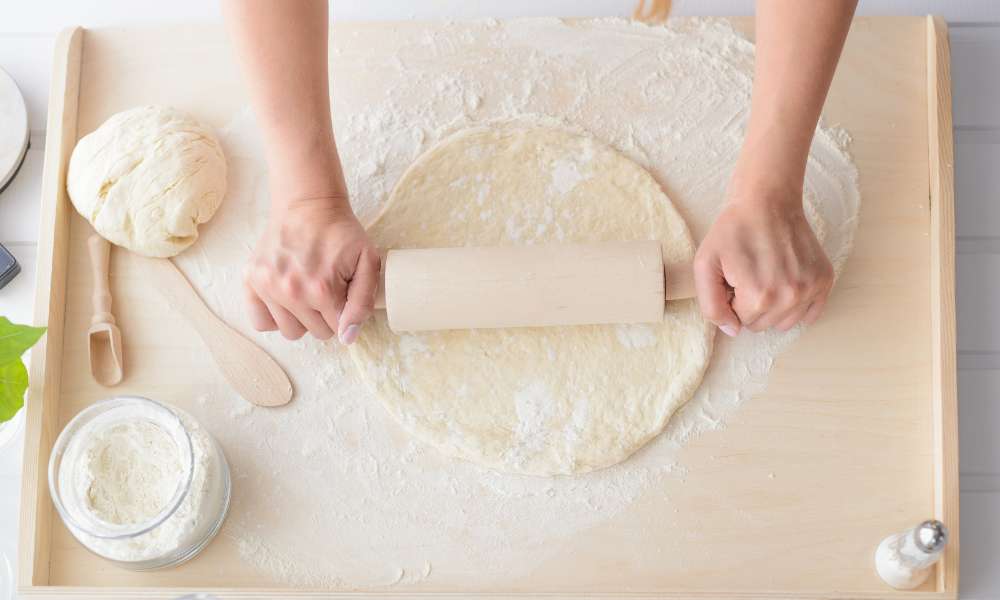There comes a time in every cook’s life when traditional tools go missing just when they’re needed most. Picture this: you’re midway through kneading a dough, only to discover that your trusty rolling pin has vanished. But fear not! Kitchen ingenuity knows no bounds. Today, we embark on a whimsical culinary adventure, exploring a variety of creative rolling pin substitutes. Not only do these alternatives add a touch of excitement to your baking routine, but they may also bring you closer to the essence of the art itself.
1. The Wine Bottle Wonder

An ordinary wine bottle may seem an unlikely companion in the world of baking, yet it’s perhaps the most popular rolling pin substitute. Its smooth, cylindrical surface allows it to glide gracefully across the dough, flattening it with surprising efficiency. Whether filled or empty, a wine bottle can become your go-to baking aid. For best results, chill it first—this keeps the dough cool, ideal for pastry and pie crusts. Not only does a wine bottle add a layer of elegance to your kitchen, but it also pairs wonderfully with culinary adventures. Imagine, for instance, sipping a glass of the same wine you’re using to roll your dough—now that’s a kitchen experience to savor.
2. The Hands-On Approach: Your Palms as Tools

In the absence of a rolling pin, your hands can become the most versatile tool. Using your palms to flatten dough connects you directly with your ingredients, allowing you to feel its elasticity and adjust pressure as needed. To achieve an even thickness, start at the center of the dough and work your way outward. Let your hands press, shape, and smooth with care. Embracing this tactile approach not only allows for creative shaping but also reintroduces a sense of intimacy with your food. After all, many a dish has been perfected by nothing more than a pair of skillful hands.
3. The Canned Goods Clue
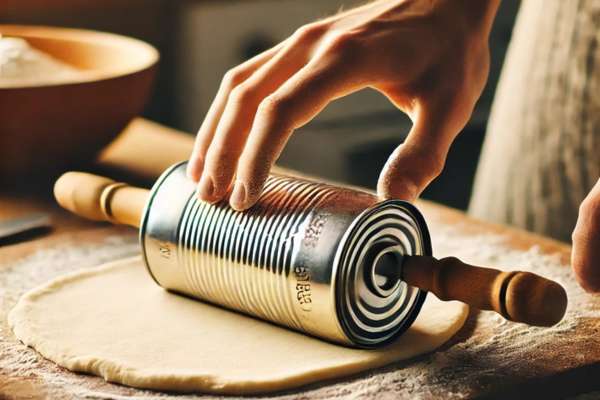
Another unexpected hero in the world of rolling is the humble can of vegetables. Cans come in a variety of sizes, making them ideal for rolling out smaller doughs or creating delicate layers. To begin, select a can that fits comfortably in your hands and ensure it’s thoroughly cleaned. A can of soup or beans can effortlessly flatten a pie crust or pizza dough. Cans are especially useful in busy kitchens where tools are often scarce, proving that a bit of resourcefulness can transform any space into a hub of creativity.
4. PVC Pipe (Food Grade)
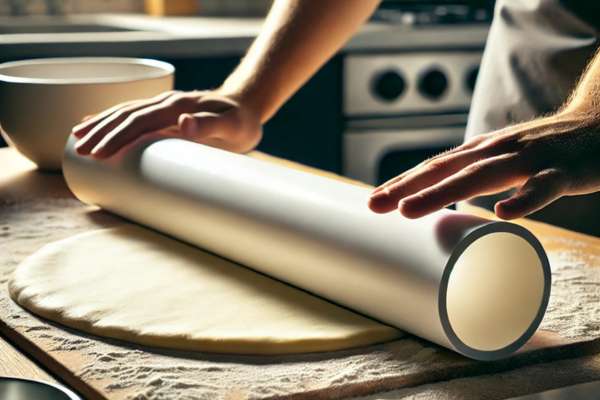
For a more professional feel, a food-grade PVC pipe can act as a durable and hygienic substitute for a rolling pin. Lightweight yet sturdy, this tool can be cut to your preferred length, making it especially practical for tasks like flattening dough for larger baking projects. A quick wash, and it’s ready to roll.
PVC pipes provide a sleek, even surface for effortless rolling, gliding over dough with ease. With a few rotations, you can achieve consistent thickness without worry. This option is perfect for those who enjoy a bit of DIY in the kitchen, bringing an industrial touch to the art of baking.
5. Magazine or Book Covered in Plastic Wrap
In a pinch, a thick magazine or book wrapped in plastic can work wonders for rolling dough. This lightweight option allows for a surprising degree of control and consistency. Wrap the item securely in plastic wrap to prevent any contact between the dough and the cover. This makeshift rolling pin offers an enjoyable experience, blending utility with a touch of whimsy. It’s a resourceful approach, perfect for those moments when creativity takes precedence over conventionality. Furthermore, it’s an excellent conversation starter, showcasing your resourceful nature to anyone who happens to stop by.
6. The Pastry Mat Magic
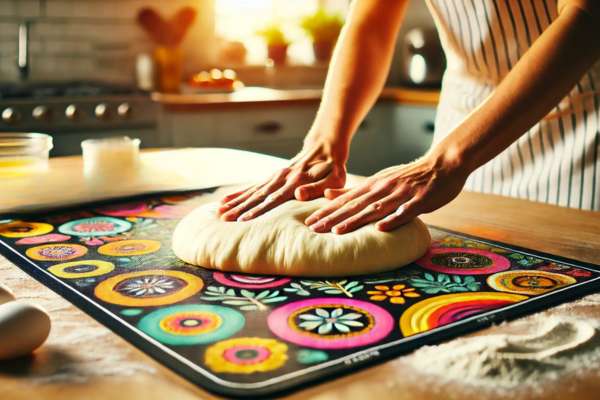
Pastry mats may not traditionally be thought of as rolling tools, but they can serve as effective substitutes. These mats are designed to keep dough from sticking, and they provide a surface for stretching and flattening doughs without the need for a pin. To use a pastry mat, simply place your dough on the mat and gently press down with your hands, pulling the dough outward to your desired size. Pastry mats bring color and vibrancy to your kitchen and are easy to clean afterward, making them as functional as they are fun to use.
7. Using Wax Paper for Rolling Out Dough
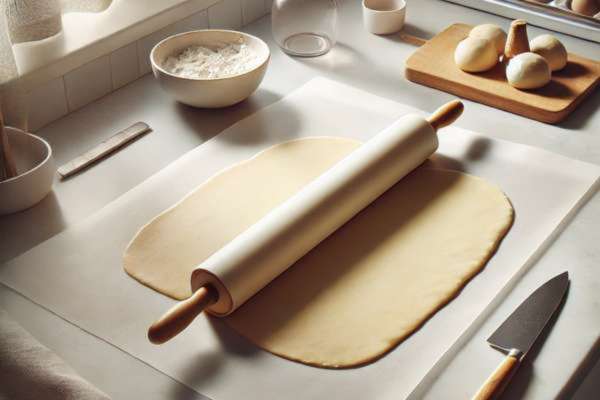
Wax paper is a hidden gem when it comes to rolling out dough. By placing your dough between two sheets of wax paper, you can eliminate the need for direct contact and avoid any sticking or tearing. This method minimizes mess and allows for even rolling with lighter items like wine bottles or small cans. For those who enjoy a clean workspace, wax paper adds a layer of efficiency to the process, and it’s also a fantastic option for delicate doughs that require a gentle touch. Smooth, mess-free, and effortlessly efficient—wax paper proves itself as a baker’s secret weapon.
8. Slicing Tools: Knives as Rolling Reimaginers
A sharp knife might seem an unusual choice for rolling, but it can serve a dual purpose for dough shaping. Use the flat side of the knife blade to press down on smaller sections of dough, flattening as you go. This technique can be particularly useful for delicate doughs where precise control is key, such as for pastry crusts or thin cookies. Ensure that your fingers are kept well clear of the blade, and with steady hands, enjoy the rhythmic process of shaping by slicing.
9. A Whisk’s Disguise: Twirl It Like You Mean It!
Let’s get a little playful here: a whisk, with its rounded, open frame, can be wielded as an unconventional tool for pressing dough. Gently flattening with a whisk not only compresses the dough but also imprints a unique texture. To maximize its effectiveness, hold the whisk’s handle and press the base into the dough, allowing you to spread and shape with an unexpected sense of fun. The whisk’s shape adds variety to the surface of the dough, creating delightful imperfections that reflect the spontaneity of your kitchen.
10. Common Mistakes to Avoid When Using a Substitute
Avoid using rough or textured surfaces, as these can leave imprints on your dough. Also, don’t roll your dough too thin or too thick—aim for the intended thickness of the recipe. Lastly, ensure that your chosen substitute is thoroughly clean, dry, and safe to use with food.
11. How to Clean and Care for Your Substitute Tools
Different materials require unique cleaning methods. Glass can be easily wipe down, while metal may need additional drying to prevent rust. For wood, be sure to avoid soaking it, as it can absorb water and warp over time. If you plan on reusing the item for culinary purposes, a thorough wash and proper storage will keep it in top condition.
Conclusion
Baking is more than a recipe—it’s an experience of creativity and resourcefulness. As you venture into the world of rolling pin substitutes, remember that culinary innovation often arises from necessity. Embrace the adventure, celebrate spontaneity, and invite a touch of whimsy into your kitchen. These substitutes offer more than just a practical solution. They encourage you to see cooking as an art, where the journey is just as important as the destination. So, next time you find yourself without a rolling pin, take it as an invitation to experiment, explore, and enjoy the boundless possibilities of baking.
